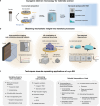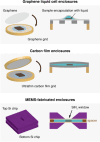Unravelling complex mechanisms in materials processes with cryogenic electron microscopy
- PMID: 39697416
- PMCID: PMC11651391
- DOI: 10.1039/d4sc05188b
Unravelling complex mechanisms in materials processes with cryogenic electron microscopy
Abstract
Investigating nanoscale structural variations, including heterogeneities, defects, and interfacial characteristics, is crucial for gaining insight into material properties and functionalities. Cryogenic electron microscopy (cryo-EM) is developing as a powerful tool in materials science particularly for non-invasively understanding nanoscale structures of materials. These advancements bring us closer to the ultimate goal of correlating nanoscale structures to bulk functional outcomes. However, while understanding mechanisms from structural information requires analysis that closely mimics operation conditions, current challenges in cryo-EM imaging and sample preparation hinder the extraction of detailed mechanistic insights. In this Perspective, we discuss the innovative strategies and the potential for using cryo-EM for revealing mechanisms in materials science, with examples from high-resolution imaging, correlative elemental analysis, and three-dimensional and time-resolved analysis. Furthermore, we propose improvements in cryo-sample preparation, optimized instrumentation setup for imaging, and data interpretation techniques to enable the wider use of cryo-EM and achieve deeper context into materials to bridge structural observations with mechanistic understanding.
This journal is © The Royal Society of Chemistry.
Conflict of interest statement
There are no conflicts to declare.
Figures









Similar articles
-
Cryogenic Electron Microscopy for Energy Materials.Acc Chem Res. 2021 Sep 21;54(18):3505-3517. doi: 10.1021/acs.accounts.1c00183. Epub 2021 Jul 19. Acc Chem Res. 2021. PMID: 34278783
-
Conventional Electron Microscopy, Cryogenic Electron Microscopy, and Cryogenic Electron Tomography of Viruses.Subcell Biochem. 2024;105:81-134. doi: 10.1007/978-3-031-65187-8_3. Subcell Biochem. 2024. PMID: 39738945 Review.
-
Structural dynamics: review of time-resolved cryo-EM.Acta Crystallogr D Struct Biol. 2022 Aug 1;78(Pt 8):927-935. doi: 10.1107/S2059798322006155. Epub 2022 Jul 21. Acta Crystallogr D Struct Biol. 2022. PMID: 35916218 Free PMC article. Review.
-
Atomic-Resolution Cryogenic Scanning Transmission Electron Microscopy for Quantum Materials.Acc Chem Res. 2021 Sep 7;54(17):3277-3287. doi: 10.1021/acs.accounts.1c00303. Epub 2021 Aug 20. Acc Chem Res. 2021. PMID: 34415721
-
A Beginner's Guide to Cryo-EM for Battery Research.Nano Lett. 2025 May 7;25(18):7210-7223. doi: 10.1021/acs.nanolett.5c00740. Epub 2025 Apr 22. Nano Lett. 2025. PMID: 40261991 Review.
References
Publication types
LinkOut - more resources
Full Text Sources

